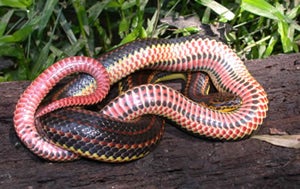SCIENTIFIC NAME:
Farancia erytrogramma erytrogramma (Palisot de Beauvois)
OTHER NAMES:
Hoop Snake, Eel Moccasin, Horn Snake, Red-lined Snake, Red-lined Horn Snake, Red Swamp Snake, Sand Hog, Sand Snake, Striped Wampum (Wright and Wright 1994) Stinging Snake, and Thunderbolt (Mount 1975).
STATUS:
Rare and possibly threatened. Seldom encountered in known distribution, which includes Coastal Plain and possibly adjacent regions above Fall Line Hills. Recorded from fewer than 10 locations in Alabama. HIGHEST CONSERVATION CONCERN.
DESCRIPTION:
A large (69-122 cm [27-48 in.] long; max. length approx. 168 cm [66 in.]) snake (Conant and Collins 1991), and one of the most beautiful reptiles in Alabama (Mount 1975). Scales shiny and typically smooth; sometimes keeled above anal region. Three prominent, red, longitudinal stripes contrast against a black to bluish back. Two bold, longitudinal rows of black spots separate a rose-colored band from two lateral lemon-colored bands on belly. From the sides, lateral yellow scale rows suggest a basal, yellow-orange stripe when snake is crawling, or at rest. Eye gray to dark-blue with a carmine rim. Wedge-shaped, black head barely wider than neck. Scales around mouth and beneath head lemon-yellow. Anal scale usually divided, but occasionally single. Young similar to adults in color (Wright and Wright 1994). However, younger individuals have a sharp tip on the tail, becoming blunt with age. Typically, females larger and stouter than males, but with shorter tails. Males exhibit more ventral spots than females (Gibbons et al. 1977,Palmer and Braswell 1995).
DISTRIBUTION:
Occurs across Coastal Plain from Maryland and Virginia to Mississippi and Louisiana, extending southward into central Florida. Typically found at sites less than 30.5 meters (100 feet) in elevation. Other subspecies confined to Glades County, Florida (Mitchell 1982). Alabama distribution limited to rivers and large streams in the southeastern “half” of the state (Mount 1975).
HABITAT:
Semi-aquatic, exhibiting a preference for spring-fed runs, clear streams, and clear rivers, reportedly tolerating saltwater habitats such as, marshes, bay shores, inlets, and estuaries (Neill 1964, Palmer and Braswell 1995). Seeks cover in woody debris along stream edges and in mats of vegetation submerged in water near pond edges. Hides in pilings around boat ramps and in roots of bald cypress trees. Principally fossorial when seeking refuge on dry land for extended periods of time, burrowing less than three meters (10 feet) into sandy soils near marshy areas. Moves about on rainy nights between aquatic habitats (Neill 1964, Wright and Wright 1994).
LIFE HISTORY AND ECOLOGY:
Secretive, but active every month of year (Wright and Wright 1994, Palmer and Braswell 1995). From 20 to 50 eggs laid in excavated nests about 10 to 15 centimeters (four to six inches) below surface during July and August in dry, sandy openings. Incubation takes 75 to 80 days. Young snakes emerge from nests from September through November (Neill 1964, Ernst and Barbour 1989, Palmer and Braswell 1995). They overwinter nearby and move to aquatic retreats in early spring (Gibbons et al. 1977). In the wild, adults prey mostly on fish at night, especially the American eel; digesting prey during daylight hours on land (Neill 1964b). Observed foraging during daylight hours in Alabama (Mount 1975) and feeding on amphibians (amphiumas, sirens, tadpoles, adult frogs) and earthworms (Wright and Wright 1994). Captive specimens will eat salamanders and frogs (Neill 1964b, Mount 1975). Bullfrogs, eastern indigo snakes, eastern kingsnakes, hawks, river otters, raccoons, and skunks prey on adults, juveniles, and/or their eggs (Neill 1964b, Wright and Wright 1994, Palmer and Braswell 1995).
BASIS FOR STATUS CLASSIFICATION:
Infrequently encountered within known distribution in Alabama, because it is either rare, secretive, or both. Population levels and status in Alabama currently unknown. Many aquatic habitats in the Coastal Plain have been altered by damming, channelization, poor agricultural practices, siltation, etc. The prime source of food for the rainbow snake is the American eel, which lives in fresh water, but must return to the sea to spawn. Damming of waterways typically restricts the seasonal migration of eels, reducing the rainbow snake’s food supply upstream from dams. Road-killed rainbow snakes have been encountered along the causeway (U.S. Highway 98) across the Mobile-Tensaw Delta (Baldwin County).
Author:
Mark H. Hughes and David H. Nelson






